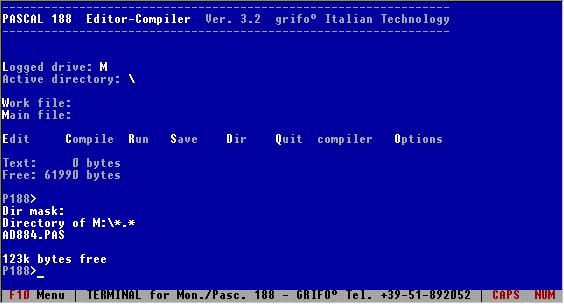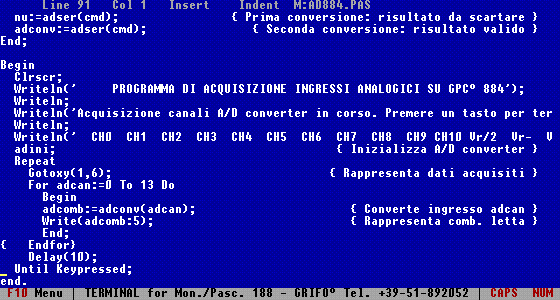PASCAL-188
Complete PASCAL
Compiler
for cards with
x86 code compatible

PASCAL-188 is a powerful software development tool which
allows high-level programming in PASCAL on all the grifo® boards
based on Intel 80C188 microprocessor
family. The code compiled by PASCAL-188 needs to use the
functions and features of GDOS-188, a Rom-Based
Operating System. The development environment is extremly
friendly and achieves to reduce the development time. Unexperienced
programmers will be able to take advantage of its numberouses
commands and functions, becoming productive in few hours of work,
while experienced programmers won't need any training. However
the great code performance and the rapidity of hardware intervents
make the PASCAL-188 an unreplaceable work instrument for
all the applications.
The compiler supports mathematic functions, control applications,
data base management, interfacing to generic consoles, Operating
System calls and many other features designed to solve industrial
automation problems. Its strictness allows to write only structrured
program, obtaining a level of efficence and flexibility hard to
find in other development tools of equal price.

G E N E R A L I T Y
PASCAL-188 is a programming and development environment
made by a set of independent items that can be used or not by
the programmer, without any limitation. Wishing to make comparisons
amongst PASCAL-188 and other well-known PASCAL programming
tools, we detect that PASCAL-188 has an environment and
instruction set comparable to those of Borland
Turbo PASCAL's Ver. 3.0.
PASCAL-188 enables to take the greatest advantage of
the hardware resources from the boards you are using, because
you may use them directly through the high-level instructions,
with no need to develop specific firmware. For example, PASCAL-188
has the capacity to manage hardware resources like serial lines,
printers, mass storage devices, operator interfaces, etc.
PASCAL-188 software package is made up by a set of disks,
a rich reference manual and a great number of examples (both source
and compiled code) showing how to use the control board's hardware
resources.

PASCAL-188 FEATURES
Basically PASCAL-188 has two main working modalities:
editor mode and command execution mode. The main characteristics
of these two modalities are described as follows:
- Pascal source saved on a single file or divided in submodules
linked together with include tecnique. This possibility increases
the total application program dimension and at the same time
it speeds the maintenance and it increases the readability.
- Standard syntax; it allows to reuse code written and already
tested on other PASCAL programming environments.
- Powerfull and fast integrated editor that lets the user write
its application program directly from the developing environment.
- Six different data types: boolean (true or false), byte (0÷255),
integer (-32768÷+32767), real (-1E-38÷+1E+38 with
11 significant digits), char and string.
- Management of structured data, either homogeneus (array and
matrix) or not (record and field).
- Wide range of operators including mathematical, relational,
logical, shift operators, precedent, subsequent, etc.
- Complete set of functions including trigonometric, trascendental,
scalar and utility functions.
- Support for the most commonly used numeration bases (hexadecimal
and decimal).
- Instruction set dedicated to the use of an operator interface
(cursor positioning, partial or total screen clear, check for
key pressed, data input, etc.). By means of these functions you
may directly control the GET-188 terminal emulation program.
- Wide range of GDOS-188 file system management instructions
set. There is no more need for low-level memory and data area
management. GDOS-188 takes care of this by manipulating
RAM data files, which can be created, deleted, renamed, copied,
downloaded etc. PASCAL-188 supports some different file
types to better satisfy the requirements of data base management.
- Interesting string manipulation instructions set (concatenation,
fragmentation, search, conversion etc.).
- Availability of pointers and of pertinent functions and operators.
- Powerfull control flow instructions set, which allows to
perform iterations, single or multiple tests, define functions
and procedure, run other programs etc.
- Basic low-level hardware resources management instructions
set, like I/O instructions, direct memory access, machine
code and assembly language routines, absolute calls to external
procedures, interrupts management, etc.
- High level devices management instructions set, which, by
means of GDOS-188 features, allows easy use of peripherals
like printer and serial lines.
- Different compilation modalities and options which permit
to optimize compilation times and compiled code.
- On line help, easy to use and capable to give a whole description
of any part of PASCAL-188, makes training faster.
- No license fee or overcharge;
developers are free to create programs without even informing
grifo®.
Normally the development of a user application program, consist
of the following phases:
- 1) write or correct the source code of the application
(this phase can be performed by the integrated editor or an external
ASCII editor, like the GET-188's one).
- 2) upload the source to the board using the features
of GDOS-188 file system.
3) compile the uploaded program, to get the compiled code.
In case of error, please return back to point 1
4) execute the compiled code directly on the control board
. If during the functional test of the program problems are detected,
you must go back to point 1
5) recompile the code in the final GDOS-188 executable
form (for example ready for EPROM, or FLASH EPROM burning).
PASCAL-188 REQUIREMENTS
Only three elements are required to be immediatly up and running:
- An 80C188 based control
board, like:
- A GDOS-188 operating system for the desired control
board.
- A personal computer, connected to the control board through
a serial line.
Page updated at 30 October
2003
 Home
Home  Languages
Languages  Utility
Utility
 Software
Tables
Software
Tables



